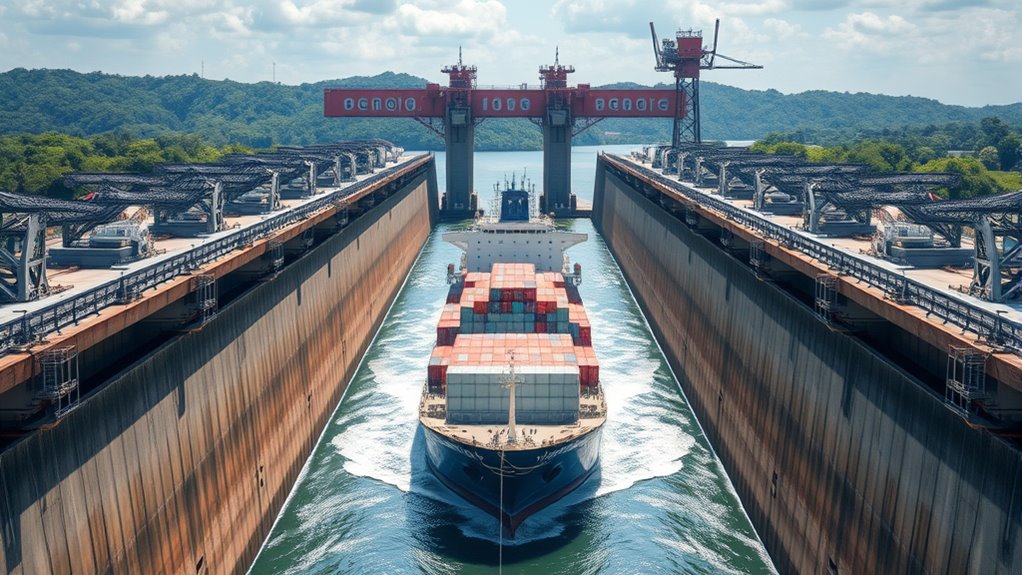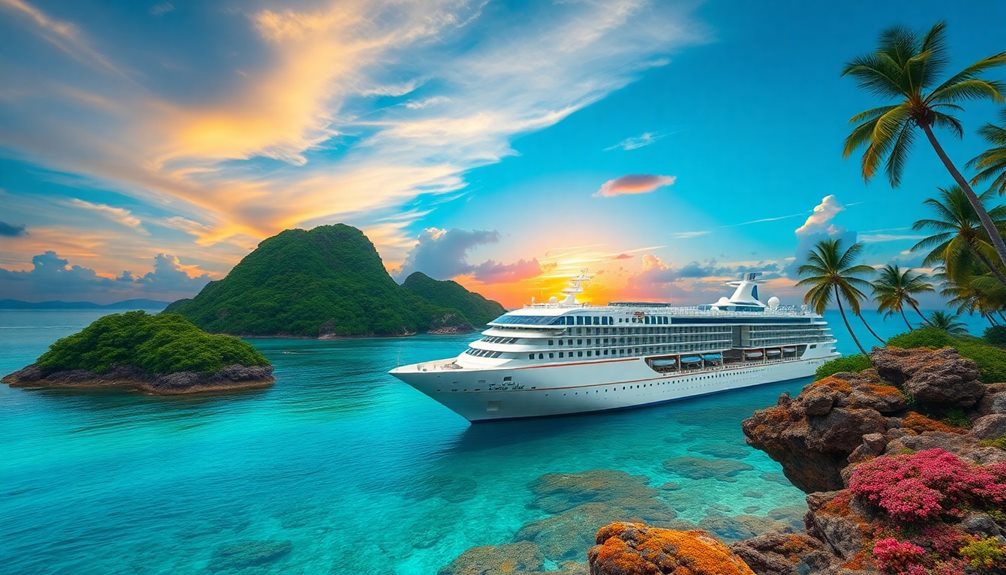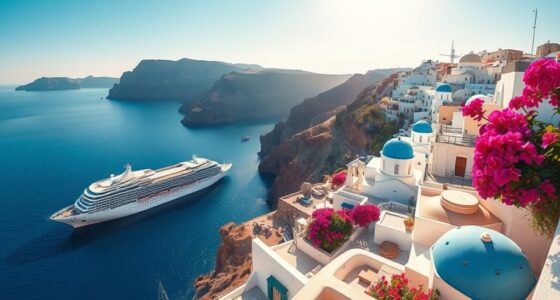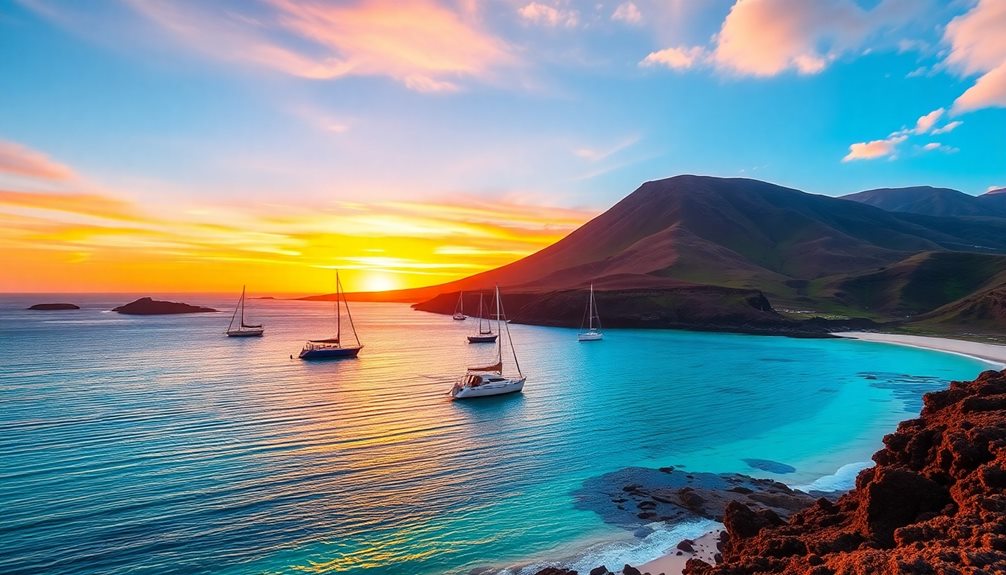To complete a full transit of the Panama Canal, you need to secure a reservation in advance and arrive at the designated port to check in. During the process, your ship will pass through a series of sophisticated locks that lift and lower vessels using advanced systems and skilled operators. The entire journey, lasting about 8 to 10 hours, showcases impressive engineering and environmental efforts. Keep exploring to discover more fascinating details about this global shipping marvel.
Key Takeaways
- Reserve a transit slot in advance and arrive at the designated port for check-in and preparation.
- Understand the lock system operation, including vessel positioning, securing, and movement through the locks.
- The transit typically takes 8 to 10 hours, involving passage through multiple lock chambers and engineering features.
- Be aware of infrastructure upgrades, such as accommodating Neo-Panamax ships and modern water management systems.
- Learn about environmental considerations and safety procedures maintained during the canal’s operation and transit process.

Are you planning to transit the Panama Canal and wondering what to expect? Knowing how the process works can make your journey smoother and more enjoyable. The Panama Canal is one of the world’s most important waterways, connecting the Atlantic and Pacific Oceans and revolutionizing global shipping logistics. Its strategic significance stems from its ability to drastically reduce the time and distance ships require to travel between these major trade routes. When you go through the canal, you’ll be witnessing a marvel of engineering that has a fascinating canal history, dating back to its initial conception in the 16th century, with the modern lock system completed in 1914. Understanding this history enhances your appreciation of the canal’s role in shaping international commerce today.
Your transit begins with booking a slot, which is essential due to the high volume of ships passing through daily. Once you’ve secured your reservation, you’ll arrive at the designated port, where you’ll check in and prepare for the journey. The canal is equipped with sophisticated lock systems that lift and lower ships to navigate the varying water levels across the isthmus. These locks operate seamlessly, but it’s helpful to know that the process involves a team of skilled operators, and your vessel will be securely guided through each phase. During the transit, you’ll be able to observe the operational logistics firsthand—how ships are carefully positioned, secured, and moved through the locks in a coordinated manner to ensure safety and efficiency. Remote Hackathons have shown how digital platforms can facilitate collaboration, which is increasingly relevant in modern logistical operations like the canal.
The canal’s history is deeply intertwined with international efforts to facilitate world trade, and the modern transit process reflects ongoing innovations in shipping logistics. As your vessel moves through the locks, you’ll see how the infrastructure has been upgraded over the years to accommodate larger ships, including the famous Neo-Panamax vessels. You might also notice the technical marvels like the reservoir system and the Gatún Lake, which provide the water resources necessary for lock operation. The entire process typically takes around 8 to 10 hours, depending on traffic and weather conditions. Throughout your journey, you’ll also learn about the engineering feats and environmental considerations that have shaped the canal’s evolution.
Frequently Asked Questions
What Are the Best Times of Year to Transit the Canal?
You should aim to transit the Panama Canal during the dry season, from December to April, when seasonal weather patterns bring less rain and calmer waters. Avoid transit peak periods, typically around holidays and weekends, to minimize delays and congestion. Traveling in these months ensures smoother navigation, shorter wait times, and more predictable conditions, making your journey more comfortable and efficient. Planning ahead helps you make the most of favorable weather and transit periods.
Are There Any Specific Vessel Size Restrictions?
You should know that ship size limitations and vessel class restrictions apply when transiting the Panama Canal. The maximum vessel size is about 366 meters in length and 49 meters in width, fitting the Panamax or Neopanamax classifications. Larger ships, like post-Panamax vessels, can’t pass without special arrangements. Always check current restrictions before planning your transit, as these limits can change with canal expansions or maintenance.
How Early Should I Book My Transit?
You should book your transit as early as possible, ideally within the booking window, which typically opens 6 to 12 months in advance. This allows you to secure your preferred transit date and guarantees smooth transit scheduling. Early booking not only guarantees availability but also gives you time to prepare any necessary documentation. Don’t wait until the last minute—plan ahead to avoid disappointment and ensure a seamless transit experience.
What Are the Costs Associated With a Full Transit?
You might worry about costs impacting your trip, but don’t fret—full transit fees are quite transparent. Expect to pay for crew accommodations, which vary based on vessel size, and the transit duration, typically around 8-10 hours. These costs cover passage fees, use of locks, and canal services, ensuring a smooth journey. Planning ahead helps you manage expenses and enjoy a seamless transit experience through the Panama Canal.
Are There Amenities Available Onboard During Transit?
During your transit, you’ll enjoy luxury amenities onboard, such as comfortable lounges, fine dining options, and relaxing spas. There’s also onboard entertainment like music, movies, and informative briefings to keep you engaged. You can unwind in luxurious cabins or take in the stunning views from observation decks. These amenities guarantee your journey through the Panama Canal is not only efficient but also enjoyable and memorable.
Conclusion
As you navigate the Panama Canal, remember it’s more than just a passage—it’s a symbol of connection and human ingenuity. Like the ships that cross its waters, your journey through life involves crossings and crossings of effort and patience. Embrace each transit as a reminder that, much like the canal’s engineers, you have the power to carve pathways through challenges, shaping your own passage to progress. Keep moving forward; the world is waiting on your next voyage.










